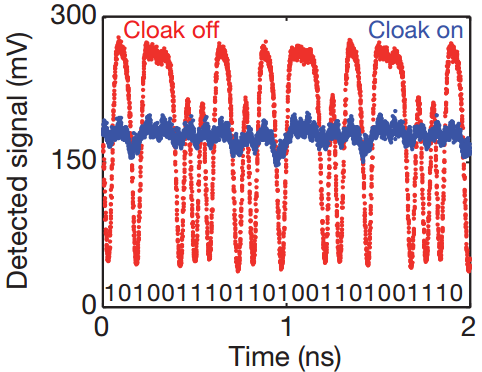‘Temporal cloaking’ could bring more secure optical communications
June 7, 2013

With cloak off, for transmitted data (the sequence of ones and zeros at the bottom) the 1 and 0 bits are represented by different voltage levels in the corresponding signal (red), allowing for easy detection of the data. But with cloak on, the voltage swings in the bit transmission (blue) are suppressed to a nearly flat line, making detection difficult.
Purdue University researchers have demonstrated a method for “temporal cloaking” of optical communications, representing a potential tool to thwart would-be eavesdroppers and improve security for telecommunications.
“More work has to be done before this approach finds practical application, but it does use technology that could integrate smoothly into the existing telecommunications infrastructure,” said Purdue graduate student Joseph Lukens, working with Andrew Weiner, the Scifres Family Distinguished Professor of Electrical and Computer Engineering in the Ultrafast Optics and Optical Fiber Communications Laboratory.
Unlike spatial cloaking, temporal cloaking does not require metamaterials, just commercially available phase modulators and optical fibers. The effect is called temporal cloaking because it hides data being transmitted over time, as opposed to “spatial” cloaking, which is used to hide physical objects in space.
How it works
The technique works by manipulating the phase, or timing, of light pulses. Controlling phase allows the transmission of signals in ones and zeros to send data over optical fibers. A critical piece of hardware is a component called a phase modulator, which is commonly found in optical communications to modify signals.
In temporal cloaking, two phase modulators are used to first create the holes, and two more to cover them up, making it look as though nothing was done to the signal.
“It’s a potentially higher level of security because it doesn’t even look like you are communicating,” Lukens said. “Eavesdroppers won’t realize the signal is cloaked because it looks like no signal is being sent.”
Such a technology also could find uses in the military, homeland security or law enforcement.
“It might be used to prevent communication between people, to corrupt their communication links without them knowing,” he said. “And you can turn it on and off, so if they suspected something strange was going on you could return it to normal communication.”
Other researchers in 2012 invented temporal cloaking, but it cloaked only a tiny fraction — about a 10,000th of a percent — of the time available for sending data in optical communications. Now the Purdue researchers have increased that to about 46 percent, potentially making the concept practical for commercial applications.
The technique could be improved to increase its operational bandwidth and the percentage of cloaking beyond 46 percent, he said.
While the previous research in temporal cloaking required the use of a complex, ultrafast-pulsing “femtosecond” laser, the Purdue researchers achieved the feat using off-the-shelf equipment commonly found in commercial optical communications.
The project was supported in part by the National Science Foundation and the U.S. Naval Postgraduate School under the National Security Science and Engineering Faculty Fellowship program. Financial support also came from the U.S. Department of Defense through a National Defense Science and Engineering Graduate Fellowship.